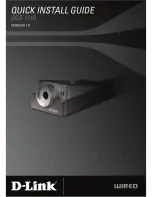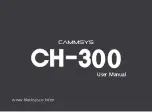
Maintenance of housing and ports
6. Lubricate the O-ring with a thin layer of Aquatica O-ring
lubricant (# 19213) until it appears to be smooth and shiny.
Do not over lubricate. Use just enough lubricant so the O-ring
will pull smoothly through your fingers. Excessive amounts of
grease will only serve to attract and trap dirt onto the o-ring.
7. Confirm that the Port and extension ring O-rings are properly
and evenly seated in their O-ring groove.
8. To reinstall the clean and lubricated main O-ring of the housing,
first place the entire O-ring over the groove and start by pushing
the O-ring in at each corner then, push the O-ring at each side
and finally, work in the rest of the O-ring. Never start at one end
and work your way around the O-ring. This places uneven
tension on the O-ring which may cause the O-ring to stretch
resulting in excess O-ring, which will have no place to go.
The internal O-rings on the housing controls are not user
accessible, while these O-rings are not as susceptible to damage
as they are not exposed, rinsing properly with fresh water to
flush out salt crystals and sand residues will be the proper way
to assure trouble free operation, Aquatica recommended yearly
maintenance of the internal O-ring. Authorized service center,
both the continental USA and Europe, are available to the users
for this service. Prior to sending the housing, always check for
the closest service center to you on our website
www.aquatica.ca
WARNING:
Use only petroleum
free O-ring lubricant such as our
# 19213 Aquatica O-ring Lubricant,
petroleum based lubricant, used
by some manufacturers for
lubricating their Silicone made
O-rings can and will cause the
O-ring material to swell, this will
render the O-ring difficult to install
and likely will result in the O-ring
being damaged or pinched with
dire consequence.
Port maintenance:
Your ports are an essential part of the optical formula in underwater
photographic system; As such they should be treated with the
same attention as the delicate camera lenses you own. Care
should be taken to avoid scratches on the dome and macro
ports lens surface. Acrylic is softer than glass, so minor exterior
marks are often unavoidable. However, since the indices of re-
fraction for acrylic and water are almost identical, these should
not impair image quality. Internal scratches (air side) must be
avoided as they do not fill in with water and will affect the quality
of the image.
Clean dome lenses only with soft lint free tissue. Dust on the
interior surfaces of the port can be removed with a soft camel
hair brush or a with a blower brush. Caution must be taken when
using aerosol devices as not to spray the lens material with the
liquid propellant as this may seriously affect the optical properties
of the port. Use of high pressurized air from a dive tank is not
recommended, the force of the air stream may easily dislodge a
port lens or its sealing O-ring. It is advisable that your ports be
removed and their O-ring serviced after every dive.
Maintenance of the housing mechanical components:
After every salt water dive, your housing system requires that it
be soaked and/or rinsed in fresh water. It should soak for a minimum of
30 minutes. Operate all the controls several times, while soaking,
to dislodge any trapped salt water residues.
Periodically remove the hand grips for storage and transportation
and to avoid having the thread of the attachment bolts fuse on to
the housing. Unscrew, clean and lubricate the bolts with a small
amount of WD-40 or Zinc based lubricant.
WARNING: Use WD-40 or any lubricant carefully, sparingly
and only on metal to metal surfaces. WD-40 or other petroleum
based lubricant can damage the acrylic on the ports, the optical
surfaces of a lens or O-rings.
Sacrificial anodes:
Two anodes (#54) are attached to the bottom parts of the housing
to prevent galvanic corrosion due to electrolysis, as time goes
they will deteriorates and need replacement. Contact your dealer
to order replacement (parts # 19220).
STORAGE AND TRANSPORTATION
Store and transport the housing in a sturdy, shock proof container
and avoid travelling with the camera mounted inside the housing.
In the event of an impact, especially on the external push buttons,
this could potentially be transferred to the camera controls and
damage them.
When travelling by air or in situation where atmospheric pressure
changes are foreseen, remove the port, the eye piece or open
the housing. Doing so allows equalization of the air pressure
inside the housing with the external one. Failure to do so may
cause internal pressure built up which could potentially force
ports or acrylic windows to pop out or potentially unseat their
O-ring seal.
Page 14
UB
L
R
I
G
C
N
A
I
N
R
-
T
O
MONTREAL, CANADA
TEL. 514-737-9481
WWW.AQUATICA.CA
# 19213 Aquatica Lubricant for O-ring
Содержание A7D Mk II
Страница 1: ...OPERATING MANUAL FOR AQUATICA A7D Mk II PRODUCT 20077...
Страница 2: ......
Страница 6: ...Page 3...
Страница 7: ...Page 4...


































